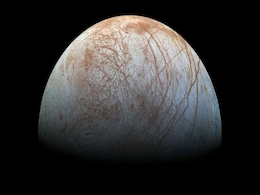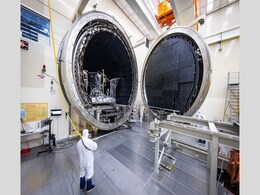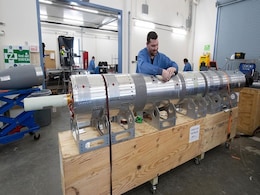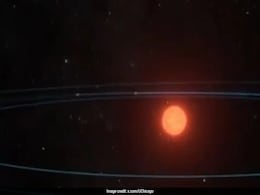Earthing Systems
- All
- News
-

X User Says "Indians Are The Most Overworked People On Earth", Sparks Discussion
- Friday June 20, 2025
- Offbeat | Edited by Bhavya Sukheja
Akshat Shrivastava, a finance advisor and a content creator, has sparked a debate online after saying that Indians are the most overworked people on earth, not by choice, but because of systemic pressures ingrained from a young age.
-
 www.ndtv.com
www.ndtv.com
-

Axiom-4 Mission Carrying Shubhanshu Shukla to International Space Station Postponed to June 22
- Wednesday June 18, 2025
- Written by Gadgets 360 Staff
India’s Shubhanshu Shukla is set to launch aboard the Axiom-4 mission on June 22 after a series of delays prompted by technical issues and safety reviews. The SpaceX-led mission will send astronauts from India, Hungary, and Poland to the International Space Station, where they will carry out over 60 experiments spanning biology, Earth science, an...
-
 www.gadgets360.com
www.gadgets360.com
-

Europa Could Briefly Sustain Life When the Sun Becomes a Red Giant Star, Scientists Say
- Saturday June 7, 2025
- Written by Gadgets 360 Staff
Scientists at Cornell’s Carl Sagan Institute propose that Jupiter’s moon Europa could host life for up to 200 million years during the sun’s red giant phase. While Earth would be incinerated, Europa’s subsurface oceans might temporarily support microbial life, offering a final refuge in the solar system and expanding the search for biosigna...
-
 www.gadgets360.com
www.gadgets360.com
-

James Webb Telescope Detects Frozen Water In Young Star System For The First Time
- Tuesday June 3, 2025
- Science | Edited by Ritu Singh
This finding has opened up new avenues for understanding the early universe and the origins of water on our planet
-
 www.ndtv.com
www.ndtv.com
-

NASA’s IMAP Spacecraft Gears Up for Mission to Explore Solar System’s Edge
- Saturday June 7, 2025
- Written by Gadgets 360 Staff
NASA’s Interstellar Mapping and Acceleration Probe (IMAP) has begun final preparations at Kennedy Space Center for a launch no earlier than September 2025. The mission will position IMAP at Lagrange Point 1, a million miles from Earth, to study the solar wind and the edge of the heliosphere. The spacecraft, built by Johns Hopkins APL, will fly al...
-
 www.gadgets360.com
www.gadgets360.com
-

NASA’s IMAP Spacecraft Prepares to Map the Solar System’s Edge
- Thursday May 15, 2025
- Written by Gadgets 360 Staff
NASA’s Interstellar Mapping and Acceleration Probe (IMAP) has been delivered to the Astrotech facility near Kennedy Space Center for final preparations ahead of a tentatively planned launch in fall 2025. IMAP will map the heliosphere — the solar wind-driven bubble that shields our solar system from cosmic radiation. It is to orbit near Lagrange...
-
 www.gadgets360.com
www.gadgets360.com
-

Super Earths are Quite Common Outside the Solar System, New Study Reveals
- Saturday April 26, 2025
- Written by Gadgets 360 Staff
Using the microlensing technique, KMTNet studied the exoplanet, which is twice as big as Earth, yet smaller than Neptune. It is believed that there are more such super-Earths outside our solar system. It is common to have such planets orbiting their stars.
-
 www.gadgets360.com
www.gadgets360.com
-

Twinkling Star Reveals Hidden Plasma Structure Near Earth
- Tuesday April 22, 2025
- Science | Daniel Reardon, The Conversation
With the most powerful radio telescope in the southern hemisphere, we have observed a twinkling star and discovered an abundance of mysterious plasma structures in our cosmic neighbourhood.
-
 www.ndtv.com
www.ndtv.com
-

Scientists Finally Discover How Long a Day Lasts on Uranus
- Saturday April 12, 2025
- Written by Gadgets 360 Staff
Astronomers confirm Uranus’ rotation period using internal oscillation modeling for the first time. On Uranus, a day just lasts far longer. More precise rotational time observations of the gas giant should enable scientists to plan visits to investigate it. Unlike on Mars and Earth, savage windstorms make it far more difficult to identify the rot...
-
 www.gadgets360.com
www.gadgets360.com
-

First Future Type 1a Supernova Detected: White Dwarf Pair to Collide in 23 Billion Years
- Tuesday April 8, 2025
- Written by Gadgets 360 Staff
Astronomers have discovered a pair of white dwarf stars located about 150 light-years from Earth that are on course to collide and produce a Type 1a supernova in approximately 23 billion years. This is the first such system identified near our region of the galaxy. With a combined mass of 1.56 solar masses, the stars are slowly spiralling toward ea...
-
 www.gadgets360.com
www.gadgets360.com
-

JWST Captures Unseen Details of Exoplanets in HR 8799 and 51 Eridani Systems
- Thursday April 3, 2025
- Written by Gadgets 360 Staff
The James Webb Space Telescope (JWST) has captured groundbreaking images of exoplanets in the HR 8799 and 51 Eridani systems. By modifying its coronagraphs, astronomers allowed more starlight to pass through, revealing clearer planetary details. The study, published in The Astrophysical Journal Letters, highlights the first successful detection of ...
-
 www.gadgets360.com
www.gadgets360.com
-

NASA to Launch Three Rockets in Alaska to Study Auroral Substorms’ Impact
- Saturday March 29, 2025
- Written by Gadgets 360 Staff
NASA is conducting a rocket experiment from Poker Flat Research Range in Alaska. Three rockets will launch within a three-hour window to study how auroral substorms influence the Earth's upper atmosphere. Scientists will observe whether auroras drive vertical convection or if acoustic-buoyancy waves spread their energy over a wider region. Vapour t...
-
 www.gadgets360.com
www.gadgets360.com
-

Wolf-Rayet 104's Orbit Tilt Reduces Gamma-Ray Burst Threat, Study Finds
- Thursday March 20, 2025
- Written by Gadgets 360 Staff
New research using Keck Observatory’s instruments confirms that the orbit of Wolf-Rayet 104 is tilted 30-40 degrees away from Earth, lowering concerns about a possible gamma-ray burst. Previously, it was believed that the system’s alignment could pose a risk. However, spectroscopy data now challenges these assumptions, raising new questions abo...
-
 www.gadgets360.com
www.gadgets360.com
-

4 Small Planets Found Around One of Closest Stars To Earth: What We Know
- Saturday March 15, 2025
- World News | The Conversation
Diminutive Barnards Star is closer in size to Jupiter than to the Sun. Only the three stars that make up the Alpha Centauri system lie closer to us.
-
 www.ndtv.com
www.ndtv.com
-

4 Planets Found Orbiting Earth's Nearest Star. They Are Too Hot For Life
- Wednesday March 12, 2025
- World News | Asian News International
Astronomers have revealed new evidence that there are not just one but four tiny planets circling around Barnard's Star, the second-nearest star system to Earth.
-
 www.ndtv.com
www.ndtv.com
-

X User Says "Indians Are The Most Overworked People On Earth", Sparks Discussion
- Friday June 20, 2025
- Offbeat | Edited by Bhavya Sukheja
Akshat Shrivastava, a finance advisor and a content creator, has sparked a debate online after saying that Indians are the most overworked people on earth, not by choice, but because of systemic pressures ingrained from a young age.
-
 www.ndtv.com
www.ndtv.com
-

Axiom-4 Mission Carrying Shubhanshu Shukla to International Space Station Postponed to June 22
- Wednesday June 18, 2025
- Written by Gadgets 360 Staff
India’s Shubhanshu Shukla is set to launch aboard the Axiom-4 mission on June 22 after a series of delays prompted by technical issues and safety reviews. The SpaceX-led mission will send astronauts from India, Hungary, and Poland to the International Space Station, where they will carry out over 60 experiments spanning biology, Earth science, an...
-
 www.gadgets360.com
www.gadgets360.com
-

Europa Could Briefly Sustain Life When the Sun Becomes a Red Giant Star, Scientists Say
- Saturday June 7, 2025
- Written by Gadgets 360 Staff
Scientists at Cornell’s Carl Sagan Institute propose that Jupiter’s moon Europa could host life for up to 200 million years during the sun’s red giant phase. While Earth would be incinerated, Europa’s subsurface oceans might temporarily support microbial life, offering a final refuge in the solar system and expanding the search for biosigna...
-
 www.gadgets360.com
www.gadgets360.com
-

James Webb Telescope Detects Frozen Water In Young Star System For The First Time
- Tuesday June 3, 2025
- Science | Edited by Ritu Singh
This finding has opened up new avenues for understanding the early universe and the origins of water on our planet
-
 www.ndtv.com
www.ndtv.com
-

NASA’s IMAP Spacecraft Gears Up for Mission to Explore Solar System’s Edge
- Saturday June 7, 2025
- Written by Gadgets 360 Staff
NASA’s Interstellar Mapping and Acceleration Probe (IMAP) has begun final preparations at Kennedy Space Center for a launch no earlier than September 2025. The mission will position IMAP at Lagrange Point 1, a million miles from Earth, to study the solar wind and the edge of the heliosphere. The spacecraft, built by Johns Hopkins APL, will fly al...
-
 www.gadgets360.com
www.gadgets360.com
-

NASA’s IMAP Spacecraft Prepares to Map the Solar System’s Edge
- Thursday May 15, 2025
- Written by Gadgets 360 Staff
NASA’s Interstellar Mapping and Acceleration Probe (IMAP) has been delivered to the Astrotech facility near Kennedy Space Center for final preparations ahead of a tentatively planned launch in fall 2025. IMAP will map the heliosphere — the solar wind-driven bubble that shields our solar system from cosmic radiation. It is to orbit near Lagrange...
-
 www.gadgets360.com
www.gadgets360.com
-

Super Earths are Quite Common Outside the Solar System, New Study Reveals
- Saturday April 26, 2025
- Written by Gadgets 360 Staff
Using the microlensing technique, KMTNet studied the exoplanet, which is twice as big as Earth, yet smaller than Neptune. It is believed that there are more such super-Earths outside our solar system. It is common to have such planets orbiting their stars.
-
 www.gadgets360.com
www.gadgets360.com
-

Twinkling Star Reveals Hidden Plasma Structure Near Earth
- Tuesday April 22, 2025
- Science | Daniel Reardon, The Conversation
With the most powerful radio telescope in the southern hemisphere, we have observed a twinkling star and discovered an abundance of mysterious plasma structures in our cosmic neighbourhood.
-
 www.ndtv.com
www.ndtv.com
-

Scientists Finally Discover How Long a Day Lasts on Uranus
- Saturday April 12, 2025
- Written by Gadgets 360 Staff
Astronomers confirm Uranus’ rotation period using internal oscillation modeling for the first time. On Uranus, a day just lasts far longer. More precise rotational time observations of the gas giant should enable scientists to plan visits to investigate it. Unlike on Mars and Earth, savage windstorms make it far more difficult to identify the rot...
-
 www.gadgets360.com
www.gadgets360.com
-

First Future Type 1a Supernova Detected: White Dwarf Pair to Collide in 23 Billion Years
- Tuesday April 8, 2025
- Written by Gadgets 360 Staff
Astronomers have discovered a pair of white dwarf stars located about 150 light-years from Earth that are on course to collide and produce a Type 1a supernova in approximately 23 billion years. This is the first such system identified near our region of the galaxy. With a combined mass of 1.56 solar masses, the stars are slowly spiralling toward ea...
-
 www.gadgets360.com
www.gadgets360.com
-

JWST Captures Unseen Details of Exoplanets in HR 8799 and 51 Eridani Systems
- Thursday April 3, 2025
- Written by Gadgets 360 Staff
The James Webb Space Telescope (JWST) has captured groundbreaking images of exoplanets in the HR 8799 and 51 Eridani systems. By modifying its coronagraphs, astronomers allowed more starlight to pass through, revealing clearer planetary details. The study, published in The Astrophysical Journal Letters, highlights the first successful detection of ...
-
 www.gadgets360.com
www.gadgets360.com
-

NASA to Launch Three Rockets in Alaska to Study Auroral Substorms’ Impact
- Saturday March 29, 2025
- Written by Gadgets 360 Staff
NASA is conducting a rocket experiment from Poker Flat Research Range in Alaska. Three rockets will launch within a three-hour window to study how auroral substorms influence the Earth's upper atmosphere. Scientists will observe whether auroras drive vertical convection or if acoustic-buoyancy waves spread their energy over a wider region. Vapour t...
-
 www.gadgets360.com
www.gadgets360.com
-

Wolf-Rayet 104's Orbit Tilt Reduces Gamma-Ray Burst Threat, Study Finds
- Thursday March 20, 2025
- Written by Gadgets 360 Staff
New research using Keck Observatory’s instruments confirms that the orbit of Wolf-Rayet 104 is tilted 30-40 degrees away from Earth, lowering concerns about a possible gamma-ray burst. Previously, it was believed that the system’s alignment could pose a risk. However, spectroscopy data now challenges these assumptions, raising new questions abo...
-
 www.gadgets360.com
www.gadgets360.com
-

4 Small Planets Found Around One of Closest Stars To Earth: What We Know
- Saturday March 15, 2025
- World News | The Conversation
Diminutive Barnards Star is closer in size to Jupiter than to the Sun. Only the three stars that make up the Alpha Centauri system lie closer to us.
-
 www.ndtv.com
www.ndtv.com
-

4 Planets Found Orbiting Earth's Nearest Star. They Are Too Hot For Life
- Wednesday March 12, 2025
- World News | Asian News International
Astronomers have revealed new evidence that there are not just one but four tiny planets circling around Barnard's Star, the second-nearest star system to Earth.
-
 www.ndtv.com
www.ndtv.com
















